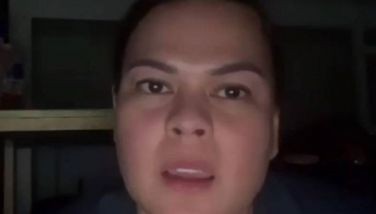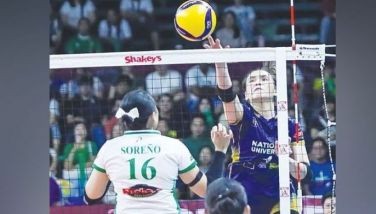Prayers, flowers for ‘585’ victims
November 19, 2002 | 12:00am
Flower petals blowing in the wind and prayers in the air.
This was the setting of the requiem Mass celebrated by Philippine Coast Guard (PCG) chaplain Edmund Desierto early yesterday morning on board the BRP Edsa II.
By 7:25 yesterday morning, the Coast Guard vessel was circling the area in Manila Bay where Laoag International Airlines (LIA) Flight 585 sank exactly one week and one hour after the Nov. 11 plane crash that killed 19 of the Fokker-27’s 34 passengers and crew.
The Mass was also celebrated to honor the joggers, swimmers, fishermen, PCG, PCG Auxiliary Corps and personnel of the Philippine Navy, Philippine National Police (PNP) and Bureau of Fire Protection (BFP) who acted as first responders to the crash.
The animosity and bitterness between LIA and crash survivors and bereaved relatives were temporarily set aside as the Mass was celebrated. The "Lord’s Prayer" was sung by a congregation that lifted their voices to heaven in unison and joined hands in prayer.
After the Mass concluded at 8:10 a.m., rescuers, crash survivors and bereaved relatives tossed white roses, red and white rose petals and funeral wreaths over the BRP Edsa II rail, only to have these floral offerings swept onto the ship’s deck by blowback.
A PCG helicopter hovered in a cloud of the red and white rose petals it had dropped like confetti over the crash site as the petals were buffeted by strong gusts of wind.
Batanes Rep. Florencio Abad, Air Transportation Office (ATO) chief Adelberto Yap, PCG commandant Vice Adm. Reuben Lista, Transportation and Communications spokesman Ralph Lantion and LIA president Jose Miranda also attended the requiem Mass.
Miranda approached the victims’ relatives and expressed LIA management’s condolences, at the same time apologizing for the misfortune that befell Flight 585’s passengers. "Please do not hesitate to let us know if there is anything we can do at this time to assuage your feelings," Miranda said.
Miranda also told journalists that eight of the 15 survivors are still recuperating at the San Juan de Dios Hospital in Pasay City and at the University of Santo Tomas (UST) Hospital in Manila.
LIA spokesman Alvin Manuel Yater said costs for the burial, hospitalization and repatriation of remains of the five Australians on the ill-fated flight were shouldered by LIA.
"All legal claims will also be reimbursed by LIA while the investigation is still ongoing," Yater said. The fishermen who were among the first to pluck survivors from Manila Bay’s murky waters, would be commended.
The families of those killed in the crash and survivors will receive $25,000 each in insurance payments from LIA insurer Heat Lambert, as required by law.
The Civil Aeronautics Board (CAB), by virtue of Republic Act 776, requires franchise-seeking airline companies to purchase insurance coverage for their aircraft, passengers and cargo before it issues a certificate of public conveyance. The CAB franchise is good for five years, while Congress issues a "legislated" franchise.
LIA chairman Paul Ng had written his apologies to the survivors and families of crash fatalities, reiterating that the airline will use all its resources and facilities to attend to the medical needs of the injured and pay for burial and other related expenses of those who perished in the mishap.
"We regret very much the accident that happened with our aircraft on Nov. 11, 2002 where your loved one died, or was injured," Ng’s letter read. "We apologize sincerely for this unfortunate incident and wish to express our deepest condolences to the family and prayers for the repose of the souls of those who died."
Fishermen Edgar Naga, 39 his brother Crispulo, 34, Edgar’s son Elorde, 12, and Edgar’s adopted son, Rico Cayabyab, 15, Lucio Gottib, 33, Eliseo Esmerito, 47, and Rustom Mira, 38, will receive commendations for being among the first to assist survivors that fateful Monday.
"We’re not heroes. Heroes fight for the country, all we did was save people," Edgar told The STAR at the Mass.
Edgar said he was happy he had ferried nine of the crash survivors to shore adding that he and the other first-responders to the tragedy had to dive for some of the victims and haul them to the surface. "We used compressors because we did not have scuba (equipment)."
"I did not need to ask for help. The people (on the shore) ran into the water, getting their shoes and pants wet, to help get the survivors to shore."
"I thought we were just being brought to the PCG office to be interviewed. We did not expect this honor," he said.
Edgar’s youngest son, 12-year-old Elorde, was with him at the time of the crash and helped by holding their outrigger canoe steady while the elder Naga plucked the survivors from the sea.
Rico Cayabyab, 15 years old and Edgar’s adopted son, also assisted in the rescue. "I felt strong," Cayabyab said.
"I felt happy to see the people on the shore helping us save the survivors and rushing to bring them to the hospital," Crispulo said.
He survives solely by fishing, is married with children aged 15, 12 and three years and lives in a squatter area in Tambo, Parañaque City.
Crispulo and his brother spend an average of P550 daily for fuel and boat and fishing gear maintenance. On a lean day, they take nothing home but expenses - "abunado." On good days, they earn P200 to P300.
Navy Seal Lt. Cmdr. Ross Sarmiento, 37, said he and his unit "hadn’t eaten breakfast yet when we learned of the accident."
Sarmiento’s unit sped in two motorboats from Sangley Point naval base in Cavite and in just over 12 minutes was at the crash site.
During the search operation, Sarmiento felt "the pressure of the time element because, when the sun goes down, the visibility (is diminished), and of weather conditions. It was good the good weather (held)."
"You feel compassion for the people, but you have to relieve them of the burden of not knowing where their loved ones are... You have to think positively," Sarmiento said, "if not, you must recover the bodies and everything else you can."
Commander Chris Cabarrubias of the PCG Auxiliary Corps, another first-responder, expressed frustration about not being able to immediately go to the crash site. "You know lives are at stake, but someone had to get the search and rescue operation organized."
Cabarrubias said the requiem Mass was celebrated to help give the bereaved families of the victims, the rescuers and the survivors "some closure and a chance to heal from the trauma of the tragedy."
Regarding the cause of the crash, Cabarrubias, himself a pilot who has flown the F-27, said the Fokker is "one of the safest planes because it is designed to glide" from altitudes upwards of 1,000 feet. However, he refused to comment further, asking members of the press to "wait until the investigation report is released."
Senate Minority Leader Loren Legarda yesterday commended these rescuers as "modern-day heroes who disregarded their own personal safety" to rescue the 15 crash survivors.
She gave particular attention to the Naga family who, she said, "deserve our thanks." Legarda also hailed DOTC Secretary Leandro Mendoza for "fast-tracking the modernization of the (PCG)."
Legarda also extended in a press statement her condolences to the families of those who died in the accident.
Meanwhile, Volunteers Against Crime and Corruption (VACC) chairman Dante Jimenez, whose family runs a maritime school, said an independent body should be formed to investigate air, land and sea mishaps.
Jimenez said other countries have such independent fact-finding bodies that scrutinize and determine the factors that cause transport accidents. He also suggested that this proposed independent probe body be composed of retired professionals or those in private practice and members of NGOs who can make investigations move at a faster pace and monitor the progress of such cases.
"There should be an independent (body) so we will see objectivity and impartiality," Jimenez said.
He also recommended that the government tap fishermen nationwide by giving them cash incentives for participation in search and rescue and recovery operations and train them to respond to airplane crashes and boat sinkings.
"The potential of the fishermen all over the country (can be fully tapped). They are coast-watchers. They could be used to rescue victims, or monitor unusual movements of (suspected) saboteurs or terrorists," Jimenez said. "There are millions of fishermen in the Philippines."
He also said the VACC "can provide the victims’ families with moral support and legal assistance. The most difficult part of the criminal justice system is when you go (to) court, attend cases, subpoena left and right. This will take years. This will take patience." — With reports from Dulce Arguelles, Alma Anonas, Rey Arquiza
This was the setting of the requiem Mass celebrated by Philippine Coast Guard (PCG) chaplain Edmund Desierto early yesterday morning on board the BRP Edsa II.
By 7:25 yesterday morning, the Coast Guard vessel was circling the area in Manila Bay where Laoag International Airlines (LIA) Flight 585 sank exactly one week and one hour after the Nov. 11 plane crash that killed 19 of the Fokker-27’s 34 passengers and crew.
The Mass was also celebrated to honor the joggers, swimmers, fishermen, PCG, PCG Auxiliary Corps and personnel of the Philippine Navy, Philippine National Police (PNP) and Bureau of Fire Protection (BFP) who acted as first responders to the crash.
The animosity and bitterness between LIA and crash survivors and bereaved relatives were temporarily set aside as the Mass was celebrated. The "Lord’s Prayer" was sung by a congregation that lifted their voices to heaven in unison and joined hands in prayer.
After the Mass concluded at 8:10 a.m., rescuers, crash survivors and bereaved relatives tossed white roses, red and white rose petals and funeral wreaths over the BRP Edsa II rail, only to have these floral offerings swept onto the ship’s deck by blowback.
A PCG helicopter hovered in a cloud of the red and white rose petals it had dropped like confetti over the crash site as the petals were buffeted by strong gusts of wind.
Batanes Rep. Florencio Abad, Air Transportation Office (ATO) chief Adelberto Yap, PCG commandant Vice Adm. Reuben Lista, Transportation and Communications spokesman Ralph Lantion and LIA president Jose Miranda also attended the requiem Mass.
Miranda approached the victims’ relatives and expressed LIA management’s condolences, at the same time apologizing for the misfortune that befell Flight 585’s passengers. "Please do not hesitate to let us know if there is anything we can do at this time to assuage your feelings," Miranda said.
Miranda also told journalists that eight of the 15 survivors are still recuperating at the San Juan de Dios Hospital in Pasay City and at the University of Santo Tomas (UST) Hospital in Manila.
"All legal claims will also be reimbursed by LIA while the investigation is still ongoing," Yater said. The fishermen who were among the first to pluck survivors from Manila Bay’s murky waters, would be commended.
The families of those killed in the crash and survivors will receive $25,000 each in insurance payments from LIA insurer Heat Lambert, as required by law.
The Civil Aeronautics Board (CAB), by virtue of Republic Act 776, requires franchise-seeking airline companies to purchase insurance coverage for their aircraft, passengers and cargo before it issues a certificate of public conveyance. The CAB franchise is good for five years, while Congress issues a "legislated" franchise.
LIA chairman Paul Ng had written his apologies to the survivors and families of crash fatalities, reiterating that the airline will use all its resources and facilities to attend to the medical needs of the injured and pay for burial and other related expenses of those who perished in the mishap.
"We regret very much the accident that happened with our aircraft on Nov. 11, 2002 where your loved one died, or was injured," Ng’s letter read. "We apologize sincerely for this unfortunate incident and wish to express our deepest condolences to the family and prayers for the repose of the souls of those who died."
"We’re not heroes. Heroes fight for the country, all we did was save people," Edgar told The STAR at the Mass.
Edgar said he was happy he had ferried nine of the crash survivors to shore adding that he and the other first-responders to the tragedy had to dive for some of the victims and haul them to the surface. "We used compressors because we did not have scuba (equipment)."
"I did not need to ask for help. The people (on the shore) ran into the water, getting their shoes and pants wet, to help get the survivors to shore."
"I thought we were just being brought to the PCG office to be interviewed. We did not expect this honor," he said.
Edgar’s youngest son, 12-year-old Elorde, was with him at the time of the crash and helped by holding their outrigger canoe steady while the elder Naga plucked the survivors from the sea.
Rico Cayabyab, 15 years old and Edgar’s adopted son, also assisted in the rescue. "I felt strong," Cayabyab said.
"I felt happy to see the people on the shore helping us save the survivors and rushing to bring them to the hospital," Crispulo said.
He survives solely by fishing, is married with children aged 15, 12 and three years and lives in a squatter area in Tambo, Parañaque City.
Crispulo and his brother spend an average of P550 daily for fuel and boat and fishing gear maintenance. On a lean day, they take nothing home but expenses - "abunado." On good days, they earn P200 to P300.
Navy Seal Lt. Cmdr. Ross Sarmiento, 37, said he and his unit "hadn’t eaten breakfast yet when we learned of the accident."
Sarmiento’s unit sped in two motorboats from Sangley Point naval base in Cavite and in just over 12 minutes was at the crash site.
During the search operation, Sarmiento felt "the pressure of the time element because, when the sun goes down, the visibility (is diminished), and of weather conditions. It was good the good weather (held)."
"You feel compassion for the people, but you have to relieve them of the burden of not knowing where their loved ones are... You have to think positively," Sarmiento said, "if not, you must recover the bodies and everything else you can."
Commander Chris Cabarrubias of the PCG Auxiliary Corps, another first-responder, expressed frustration about not being able to immediately go to the crash site. "You know lives are at stake, but someone had to get the search and rescue operation organized."
Cabarrubias said the requiem Mass was celebrated to help give the bereaved families of the victims, the rescuers and the survivors "some closure and a chance to heal from the trauma of the tragedy."
Regarding the cause of the crash, Cabarrubias, himself a pilot who has flown the F-27, said the Fokker is "one of the safest planes because it is designed to glide" from altitudes upwards of 1,000 feet. However, he refused to comment further, asking members of the press to "wait until the investigation report is released."
She gave particular attention to the Naga family who, she said, "deserve our thanks." Legarda also hailed DOTC Secretary Leandro Mendoza for "fast-tracking the modernization of the (PCG)."
Legarda also extended in a press statement her condolences to the families of those who died in the accident.
Meanwhile, Volunteers Against Crime and Corruption (VACC) chairman Dante Jimenez, whose family runs a maritime school, said an independent body should be formed to investigate air, land and sea mishaps.
Jimenez said other countries have such independent fact-finding bodies that scrutinize and determine the factors that cause transport accidents. He also suggested that this proposed independent probe body be composed of retired professionals or those in private practice and members of NGOs who can make investigations move at a faster pace and monitor the progress of such cases.
"There should be an independent (body) so we will see objectivity and impartiality," Jimenez said.
He also recommended that the government tap fishermen nationwide by giving them cash incentives for participation in search and rescue and recovery operations and train them to respond to airplane crashes and boat sinkings.
"The potential of the fishermen all over the country (can be fully tapped). They are coast-watchers. They could be used to rescue victims, or monitor unusual movements of (suspected) saboteurs or terrorists," Jimenez said. "There are millions of fishermen in the Philippines."
He also said the VACC "can provide the victims’ families with moral support and legal assistance. The most difficult part of the criminal justice system is when you go (to) court, attend cases, subpoena left and right. This will take years. This will take patience." — With reports from Dulce Arguelles, Alma Anonas, Rey Arquiza
BrandSpace Articles
<
>
- Latest
- Trending
Trending
Latest
Trending
Latest
Recommended





























